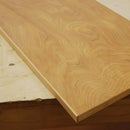Introduction: Building a Fairing Board
Fairing boards are indispensable tools. Whether working on a new boat hull, a kayak, or even doing automotive work, these simple yet highly useful pieces of equipment are a valuable addition to most any workshop. Styles can range from simple to complex, but they are relatively inexpensive to make. A good fairing board can be made in just a few hours. This Instructable will go through the process.
Materials and Tools Required:
-1/8 inch plywood cut to a dimension of 4 inches by 24 inches
-4" x 4" lumber cut to 12 inches (you can use anything from pine to maple)
-1/4 inch thick rubber sheet
-Wood lathe
-Drill press
-Screw gun
-Belt sander
-Razor blade
-Spray adhesive
-Sandpaper
Step 1: Turning the Handles
Handles for fairing boards can be easily made out of 2" x 4" pine with the edges sanded down. This is fine if you're not going to be using them for extended periods of time. But when long hours are fairing are to be performed, having more comfortable handles can make a huge difference.
The handles for this board were turned on the TechShop Menlo Park wood lathe in less than two hours. Find the centers on either end of the 4" x 4" lumber (pine in this case) and mount it on the lathe using a spur drive center and cup center. Set the spindle to between 600 to 800 r.p.m. Turn the piece down to a cylinder using a 1" roughing gouge. Begin forming the handles with a 3/8" spindle gouge. The diameter and design of the handles are based on personal preference; they should fit comfortably in your hands.
Using a compass, a pair of dividers, and a contour gauge, constantly check to ensure both handles are the same size. Don't worry about making them absolutely exact to one another; handles need to be functional, not perfect.
Once the roughing is finished, it's time to move on to the sanding.
Step 2: Sanding the Handles
With the workpiece still mounted in the lathe you can begin sanding the features. For this step you'll want to adjust the spindle to about 500 r.p.m. (higher speeds can cause too much friction). As with sanding any wood, always progress from a heavy to fine grit. However, very rough grits can cause major scratches that can be hard to remove. Start with about 100 or 120 grit sandpaper and work you way up to 220. Hold the paper firmly and use two hands to keep it from slipping. Lightly touch the paper to the workpiece. Don't keep the sandpaper in one area for too long; move quickly across the form to keep from changing any of the contours too drastically.
After finishing with the 220 grit, part off the handles using a parting tool and crosscut saw. Once the handles are removed from the main stock, sand the tops and bottoms smooth using a belt sander.
Step 3: Assembling the Board
Now that the handles are finished, it's time to assemble the main portion of the fairing board. Take the piece of 1/8" plywood, and mark the center line. Set points for the handles about two or three inches from the edge of the board. Drill and countersink a hole at each of those points.
Using a drill press, drill pilot holes into the center of the handles. Be sure to starting drilling the hole in the bottom of the handle, and do not drill all the way through. This is to keep the handle from splitting when attaching it to the board.
Place the handles over the holes, and drive a screw through until they are tight against the plywood. The screws need to be long enough that they firmly hold the handle, but short enough that they won't pierce through the top. Two inch screws are typically a good option.
Step 4: Attaching the Rubber
Adding rubber to the fairing board will give it more rigidity. More importantly, it will allow the sandpaper to float over the imperfections in the surface being sanded, and should keep the paper from gouging the surface.
Cut the rubber with a razor blade; make sure it is slightly larger than the size of your plywood. Apply spray adhesive to the plywood and firmly press the rubber onto the wood. Let the adhesive set up for a few minutes. Clamp the board into a vice and use the razor blade to trim the edges of the rubber flush with the plywood.
The final step is to add the sandpaper. For this there are a few options. You can buy rolls of sandpaper that are the width of your board. Simply cut strips and apply with spray adhesive (you can also buy rolls that have adhesive backing already). Another option is to simply buy sanding belts for belt sanders, cut them to length, and apply with spray adhesive.
Happy fairing!













